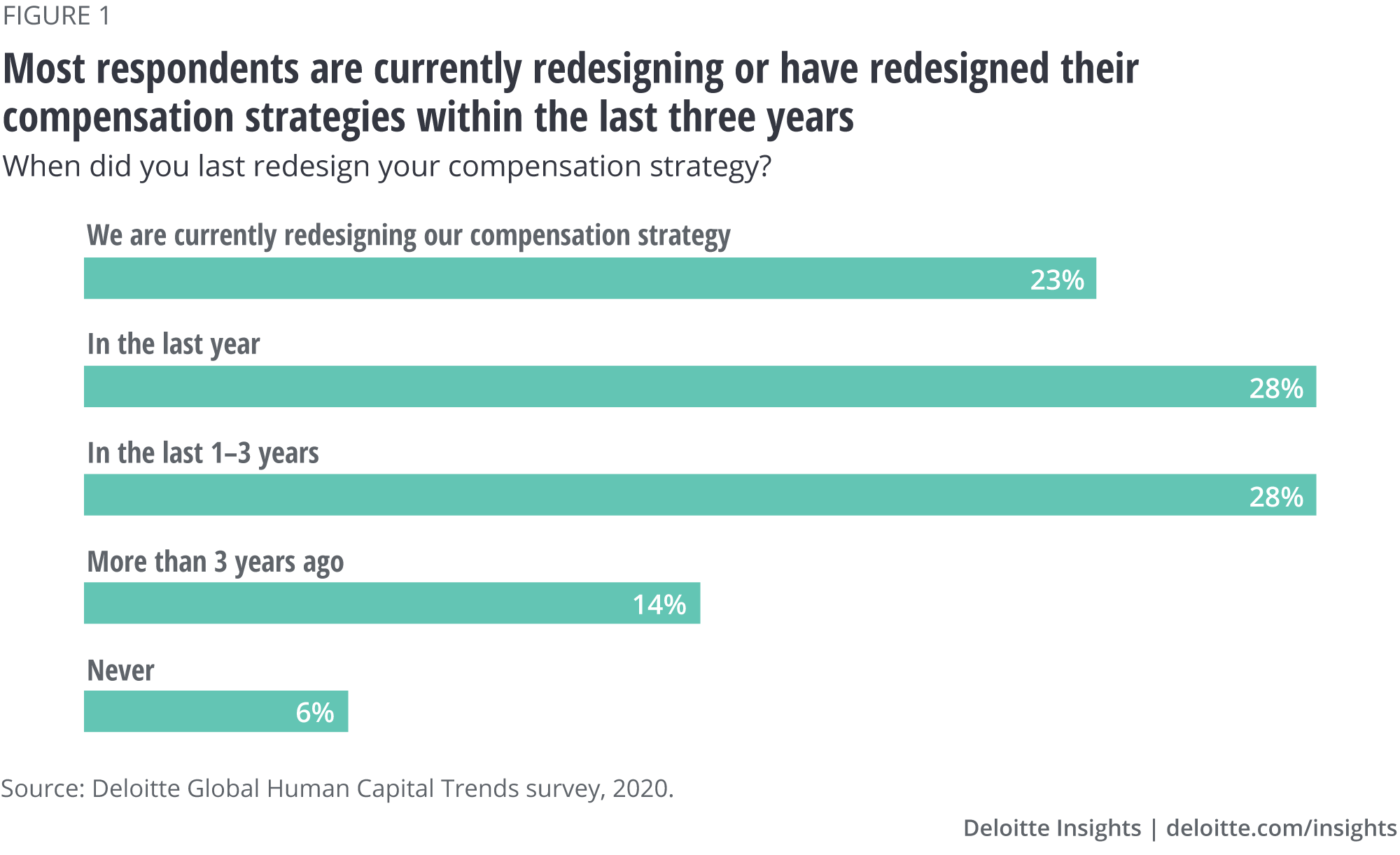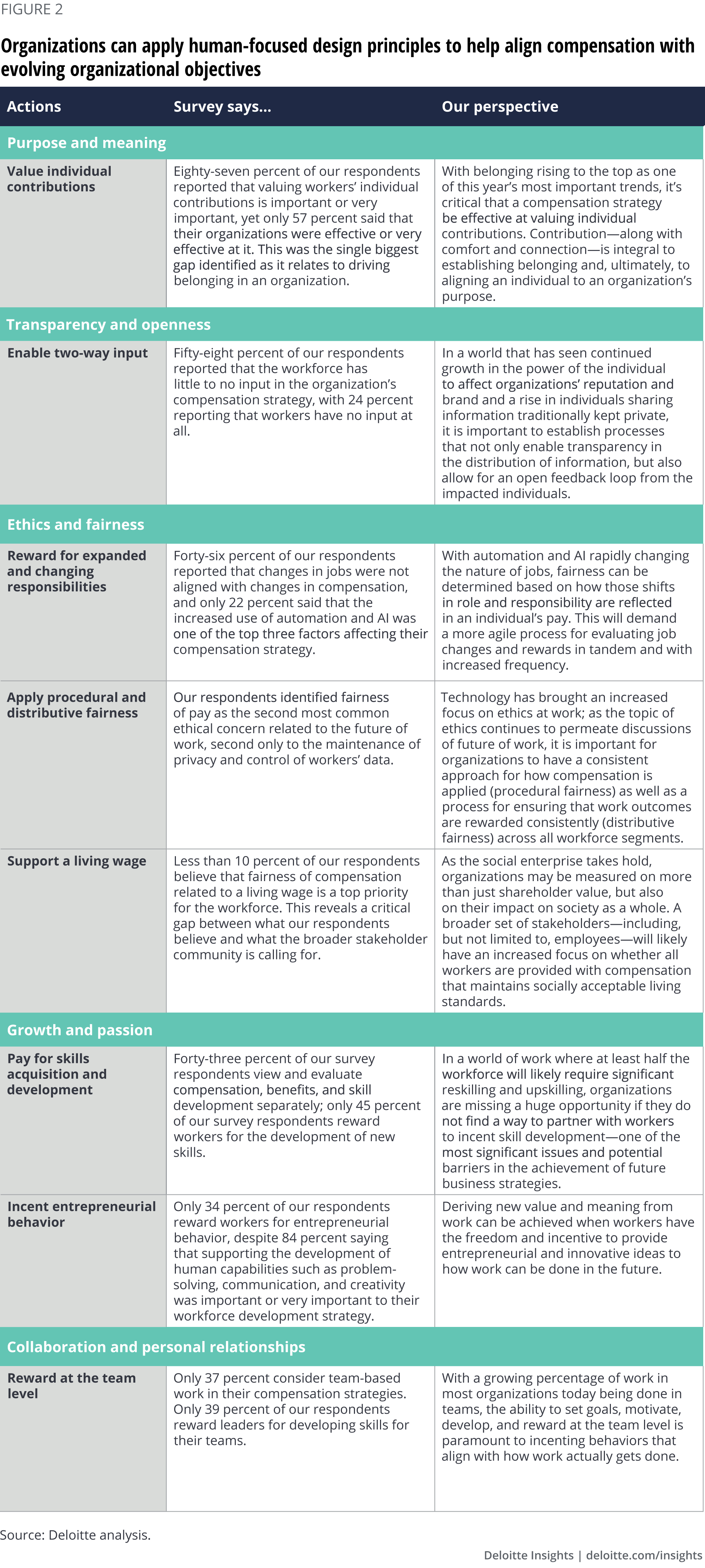
The compensation conundrum Principles for a more human approach
9 minute read
15 May 2020
Basing compensation strategies on five enduring principles of the social enterprise can help organizations navigate an uncertain environment and make bold, effective forward-looking choices.
2021 Global Human Capital Trends
Sign up to receive a copy of our new approach to Trends launching this winter
Rapid changes in the nature of work are adding new demands and pressures on compensation strategies and programs. As a consequence, many organizations are stuck in a seemingly endless cycle of compensation reviews, reforms, and rollouts. To take bold action in the face of uncertainty, organizations should look beyond compensation as a “spot market”—focused on rewards to drive talent acquisition and retention—to viewing it as a lever to manage the biggest shifts happening in today’s work environment, including changes in the way work happens, the evolving expectations of the workforce, and the expanded role of organizations as they become social enterprises. To do this effectively, organizations must focus on a core set of human principles that will enable them to craft compensation strategies designed to stand the test of time in the new world of work.
The Readiness Gap: Sixty-nine percent of organizations say the changing nature of compensation expectations and strategies is important or very important for their success over the next 12–18 months, but only 9 percent say they are very ready to address this trend.
Current drivers
Compensation—salary and wages—is the largest component of an organization’s total labor costs,1 accounting for up to 70 percent of an organization’s total costs.2 And yet many organizations seem curiously uncertain about how to approach this significant area of spend. In our 2020 Global Human Capital Trends survey, most respondents said that their organizations were either in the middle of redesigning compensation or had changed their compensation strategy within the last three years (figure 1). What’s more, 64 percent of respondents expected their organizations to redesign compensation yet again either this year or in the next three years.

Learn more
Explore the Human Capital Trends collection
Watch the video
Learn about Deloitte’s services
Order a copy of Work Disrupted, Deloitte's new book on the accelerated future of work
Explore 5 lessons from the pandemic for the future of work
Go straight to smart. Get the Deloitte Insights app
Create a custom PDF
Despite these continual efforts, our recent High-Impact Rewards study confirmed business executives’ general dissatisfaction with compensation, as it garnered an incredibly low net promoter score: negative 15—the second-lowest score for any HR-related practice in any prior study by our research group, exceeded only by performance management at negative 60.3
The uncertainty about how best to approach compensation and the lack of positive results is not surprising, given the rapidly evolving environment that compensation strategies need to address. To start is the change in radical shift in work and jobs. Not only is the “half-life” of individual skills diminishing, but entire roles are also changing as work is being redesigned to integrate human workers with robotics and AI. The World Economic Forum estimates that 42 percent of the skills required from the global workforce will change between 2018 and 2022, and that by 2022, no less than 54 percent of all employees will require significant reskilling and upskilling.4 Our own analysis of 2018 Bureau of Labor Statistics Occupation Employment Survey data suggests that as many as one-half to two-thirds of jobs across industries are ripe for disruption in the future of work.
Another big shift is the desire for greater transparency that is raising pressure on organizations as it relates to their compensation practices. A poll of workers in the United Kingdom found that 56 percent would support making their income and tax return information publicly available.5 And across the Atlantic, drivers for major ride-sharing companies launched strikes across the United States to lobby for better pay transparency.6 Such calls for greater transparency reflect a growing sentiment that organizations should bear greater responsibility for answering questions about whether compensation works—and for whom.
Compensation fairness is another significant challenge in the era of the social enterprise. As the inequality gap widens,7 external stakeholders are zeroing in on compensation, taking some organizations to task for failing to pay a living wage.8 Compensation also remains a focus point to help address potential workplace bias and improve diversity-related outcomes. New research draws a direct connection between perceptions of compensation fairness and employer brand, employee engagement, and workforce well-being. One study of workers in Sweden finds that perceived fair treatment led to higher employee motivation and healthier lifestyle decisions.9 Another study in the United States reports that women experiencing compensation inequity were twice as likely to suffer from depression and four times as likely to suffer from generalized anxiety.10
To navigate these challenges effectively, organizations need a new path forward that is anchored not only on data and benchmarks, but also on a set of principles that reflects the fact that compensation is more than a set of numbers—it’s a reflection of how organizations value individuals and how individuals value organizations. Considering how much time and money organizations spend on compensation strategies, processes, and programs—and the total cost of wages and salaries—any change to compensation practices represents a significant decision that needs to put the human element front and center to have the desired impact.
Our 2020 perspective
Compensation through the years in Global Human Capital Trends
Issues around compensation, rewards, and performance management—and the relationship among the three—appear to be a perennial challenge for HR and organizational leaders. 2014’s “Performance management is broken” and 2015’s “Performance management: The secret ingredient” suggested that organizations decouple performance management from compensation, focusing performance management on coaching and improvement while basing compensation on a worker’s skills, their value to customers, and real-world market conditions. In spite of this suggestion, organizations’ rewards practices generally remained “stuck in the past,” as we wrote in 2018’s “New rewards: Personalized, agile, and holistic.” In 2019, we highlighted the continuing gap between current rewards practices and internal and external expectations in “Rewards: Closing the gap,” encouraging leaders to view compensation and rewards in the context of cultivating lasting relationships with workers. This view of compensation as an essentially human activity continues to inform this year’s discussion, as we examine how viewing compensation from the perspective of the social enterprise’s five human-focused design principles can help organizations meet emerging challenges in this area.
To move beyond the compensation conundrum—the continual reconfiguring and tinkering with rewards packages of compensation, incentive pay, and benefits—in 2020 and beyond, business leaders and workers have the opportunity to reinvent compensation for a world of changing jobs, work, skills, and expectations and values. As a starting point for compensation’s reinvention, we return to the five principles for human design we introduced in last year’s Global Human Capital Trends: Purpose and meaning; transparency and openness; ethics and fairness; growth and passion; and collaboration and personal relationships.
We used this year’s survey data to evaluate organizations’ approaches to compensation against these principles. What we found was a series of gaps between how compensation is designed and executed today—gaps that we believe hinder an organization’s ability to align compensation to the new world of work. To help organizations address them, we have proposed actions aligned with each of the five principles that we believe are mutually beneficial, enabling organizations to reward their workers in meaningful ways and transform that meaning into quantifiable value (figure 2). These actions offer organizations an enduring foundation in which to ground their compensation strategies to break the endless cycle of compensation redesigns as changes in jobs and work continue to emerge.

By considering these principles, an organization can evaluate its compensation practices for its fit with worker needs, its efficacy in supporting goals such as worker development and marketplace competitiveness, and its sustainability with respect to broader social norms and expectations. The desired end result: a compensation strategy that improves an organization’s ability to accomplish its objectives while meeting stakeholder needs and expectations in a more transparent world.
Learning by example
A few examples show how some organizations are applying parts of the human-focused design principles to compensation. One example can be found in IKEA’s efforts to equalize wages, benefits, and experience for its part- and full-time workers in Japan. Previously, local regulations required part- and full-time workers to have different compensation and benefits structures—but this presented challenges to IKEA’s operations, as the company relies on a large share of part-time workers. In response, IKEA engaged Japan’s government to improve the legal status and rights of part-time employees, leading to landmark legislation that enabled equal benefits for all Japanese workers. As a result of making changes consistent with the new law, IKEA significantly reduced turnover and received recognition as an Employer of Choice.11
As another example, Unilever explicitly made fairness and transparency key components of its global compensation strategies. It developed a “Framework for Fair Compensation” in 2015 in an effort to make pay transparent, fair, consistent, and explainable, based on a robust process for auditing, benchmarking, and setting performance targets. In 2017, a global audit against this framework discovered that 7,252 employees in 37 different countries were paid below the living wage specified by the framework. The company immediately responded, slashing this number to 611 employees in 16 countries by the end of 2018.12
Some organizations are taking transparency and openness even further through a process that focuses on collaboration. UK-based financial services company GrantTree enables its employees to set their own salaries through an iterative, collaborative process. Employees must make a case for their proposed salary, gathering information on the market rate for similar positions, their performance and growth, and what the company can afford to pay. Their colleagues then review the proposal, ask questions, and provide feedback, and the employee then chooses a salary level. While it might be expected that people would choose the highest possible compensation, at least two GrantTree workers have chosen to voluntarily reduce their salaries after their responsibilities changed.13
Pivoting ahead
Organizations are engaged in a constant cycle of adjusting and readjusting their compensation strategies in efforts to align compensation with changing talent and business challenges. We believe that this is because many are redesigning compensation in a reactive manner without basing their strategies on enduring principles that speak to the challenges organizations face today. Designing compensation this way can help organizations navigate an uncertain environment and make bold and effective forward-looking choices.
© 2021. See Terms of Use for more information.
Explore the collection
-
The postgenerational workforce Article4 years ago
-
Superteams Article4 years ago
-
Knowledge management Article4 years ago
-
Beyond reskilling Article4 years ago
-
Governing workforce strategies Article4 years ago
-
Ethics and the future of work Article4 years ago























